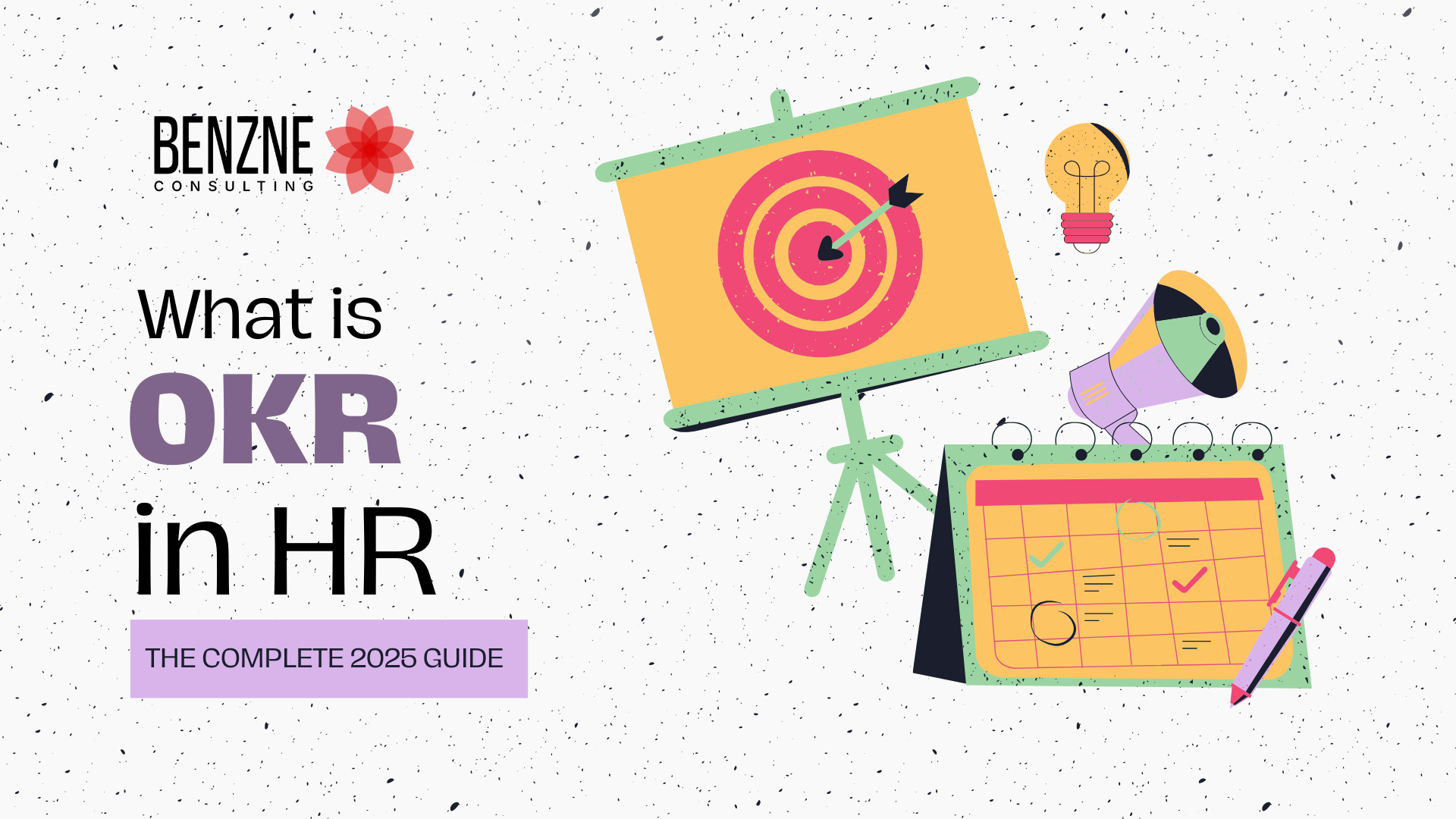Introduction
What are OKR in HR?
You’re not the only one who has been wondering what OKR in HR means. “OKR,” which stands for “Objectives and Key Results,” came from the tech industry but has now changed the way HR departments work all over the world.
HR OKRs are structured, measurable goals that help make sure that HR projects are in line with the company’s overall goals. OKRs are different from traditional HR goal-setting methods because they focus on results instead of activities. For example, instead of saying “launch a new policy” or “conduct training,” they say “increase retention by 15%” or “reduce onboarding time to less than 14 days.”
This change from measuring activities to measuring results means that HR can:
- Show leadership how important they are strategically
- Keep an eye on how it really affects business growth
- Quickly adjust to changes in the organization’s goals
Example of OKR in HR:
Goal: Create a highly productive and engaged workforce by 2025
Important Findings:
- Reach an 85% employee engagement rating on the yearly survey.
- Cut the rate of voluntary turnover from 20% to 12%.
- Raise the internal promotion rate to 25%.
OKRs assist you in transitioning from reactive problem-solving to proactive business impact, regardless of your role as HR head, HR business partner, or L&D manager.
Why are OKRs Important in HR?
In the past, HR has frequently been thought of as an administrative and compliance function. However, the position has changed, particularly since the pandemic, to become a strategic partner that drives productivity, talent, and culture.

In 2025, OKR in HR will be more important than ever for the following reasons:
1. Conformity to corporate objectives
Every HR function, from recruiting to retaining employees, supports overarching business objectives like expansion into new markets, innovation, or growth.
2. Performance driven by data
HR becomes quantifiable with OKRs. HR directors can show the board measurable outcomes rather than hazy progress reports.
3. Increased responsibility
Public, transparent OKRs guarantee that each member of the HR team is aware of their contribution to success.
4. Adaptability and flexibility
OKRs’ quarterly review cycles enable HR to make swift adjustments when priorities shift.
5. Enhanced cooperation between departments
HR, product, marketing, and sales can all work together to achieve common goals like “reduce hiring lead time to meet market launch deadlines.”
How to Write HR OKRs
It takes both imagination and accuracy to write HR OKRs for 2025 that work.
Step 1: Establish a motivating goal
Ambitious, qualitative, and inspiring goals are essential.
Step 2: Determine quantifiable outcomes
These ought to be quantifiable, time-bound, and specific.
Step 3: Steer clear of the activity trap
A to-do list is not what OKRs are. Pay attention to results rather than outputs.
Step 4: Verify alignment
The company’s OKRs and HR’s OKRs must align.
Example:
- Objective: the goal is to improve the pipeline for leaders.
- Key Results:
- Internal candidates occupy 80% of leadership positions.
- 90% of leadership training is completed, and post-program surveys show a leadership satisfaction rating of at least 8 out of 10.
How to Create HR OKRs?
Structure and teamwork are key to developing effective OKRs.
- Start by understanding the company’s yearly priorities.
- Collaborate with department heads, HR business partners, and even employees to get their opinions.
- Make use of a template. The HR PDF’s explanation of OKRs can aid in standardizing them among teams.
- Set ruthless priorities. Select three to five OKRs every three months.
- Review every three months and make adjustments if business requirements change.
Benefits of Using HR OKRs
There are observable advantages to implementing OKRs in HR:

- Laser focus: Gets rid of low-impact projects.
- Teams that are driven by stretch goals are more creative.
- Regular performance monitoring enables data-driven decision-making.
- Cultural shift: HR becomes proactive instead of reactive.
- Employee empowerment: Everybody can see how their work makes a difference.
How to Set Effective HR OKRs
- Limit scope: Don’t set more than five OKRs every quarter.
- Strive for a 70–80% success rate by striking a balance between ambition and realism.
- Maintain a regular schedule: Check-ins every two weeks are effective.
- Celebrate your progress because it creates momentum.
- Everyone should be involved, including L&D teams and recruiters.
OKRs Examples for HR Department
Here are examples of OKRs for HR across core functions:
| Objective | Key Result 1 | Key Result 2 | Key Result 3 |
| Accelerate the recruitment process | Shorten the typical time to fill a position from 45 days to 30 | Achieve a 95% satisfaction rating from hiring managers | Grow internal referrals by 20% |
| Make onboarding seamless for new hires | Attain a 90% satisfaction score among new employees | Limit first-month turnover to less than 5% | Complete all onboarding steps within 14 days |
| Strengthen commitment to diverse hiring | Guarantee that half of interview shortlists are diverse | Hire at least 40% from underrepresented backgrounds | Conduct three focused diversity campaigns |
| Improve efficiency of HR operations | Automate 60% of daily HR tasks | Cut payroll mistakes by 90% | Launch a new HR information system by Q3 |
OKRs for Training and Development
An example OKR for training and development:
Objective: Build a workplace where learning never stops
Key Results:
- Launch six new training programs across the organization before the end of 2025
- Make sure at least 85% of staff in every department take part in learning activities
- Improve employee feedback on training, raising our net promoter score from 60 to 75
Best Practices for Successful HR OKR Implementation
- Begin with a pilot group.
- Utilize OKR software to keep track of
- Conduct progress reviews every month.
- Promote openness by putting OKRs on dashboards.
- Carefully connect OKRs to performance rewards.
Why Choose OKRs for HR Teams
OKRs assist you in moving from measuring effort to measuring impact, regardless of your role as HR head or HR business partner. They contribute adaptability, clarity, and alignment—elements crucial in the fast-paced business world of today.
How to Solve HR Challenges with OKRs
| Challenges faced by HR | Recommended Objectives | Sample Key Results |
| High turnover | Employee retention OKRs (ex: increase employee retention) | Lower annual attrition rate by 15%. Boost employee satisfaction to 80% or higher. |
| Slow hiring | Recruitment specific OKRs (ex: Speed up recruitment processes) | Decrease average time-to-hire by 30%. Raise hiring manager satisfaction to 95%. |
| Low engagement | Culture & recognition OKRs (ex: Develop a more active and positive workplace) | Achieve 85% participation in engagement activities. Improve pulse survey score by 10 points. |
| Poor training impact | Learning & Development based OKRs (Strengthen training effectiveness) | Launch three new development programs. Raise training satisfaction scores by 20%. |
What are HR OKRs Focus Areas
- Hiring and choosing
- Orientation
- Diversity and inclusion in employee engagement
- Efficiency of HR operations
- Education and growth
- Pipeline for leaders
What Are Objectives and Key Results (OKRs)?
- Objective: An ambitious and motivating objective
- Key Results: Specific, quantifiable results that demonstrate success
When combined, they produce a culture that is focused on results.
How Can the Human Resource OKRs Increase HR Team Performance?
- Align individual roles with business priorities and make performance visible.
- Cut down on time lost on non-strategic tasks
- Encourage cooperation between teams.
HR OKR Example for Employee Engagement
- Objective: Make hybrid teams more engaging for employees
- Key Results:
- Increase eNPS from 55 to 80.
- Obtain 95% of respondents to the survey and conduct four engagement projects every quarter.
OKRs for HR: Education, Training and Development
For HR professionals themselves:
- Objective: Prepare the HR staff for the challenges of 2025
- Key Results:
- The new HR tech training was completed 100% of the time, and
- 3 HR leadership conferences were attended.
- Put the two new training-derived best practices into practice.
How Can Benzne Consulting Help You Implement OKRs Across HR Teams?
At Benzne, we’ve assisted HR departments across a range of sectors in utilizing OKRs.
- Tech company with more than 500 workers: had a 20% yearly turnover rate. In just one quarter, our retention OKRs decreased attrition by 12%.
- Manufacturing Client: Production was being negatively impacted by delays in recruitment. The time-to-hire was reduced from 60 to 35 days by our hiring efficiency OKRs.
- SaaS Startup: Engagement in L&D programs was low. With an 85% course completion rate, our OKR for training and development increased participation to 90%.
Our strategy consists of:
- Personalized HR OKR templates
- HR sample OKRs based on your objectives
- Workshops for OKR HR examples in operations, engagement, and recruitment
- Dashboard tracking for continued success
OKRs, in our opinion, transform HR from an administrative department into a strategic engine of growth.
Conclusion
OKR in HR is a transformation tool that goes beyond a framework for setting goals. HR directors who use OKRs will see quantifiable improvements in business performance, culture, and talent by 2025. HR teams that set and meet ambitious, quantifiable, and aligned goals will be the most successful. HR can influence culture, match strategy, and see your team grow into a real business powerhouse with the correct OKRs.
Frequently Asked Questions
1. What is the difference between OKR and KPI?
While OKRs set ambitious, time-bound goals, KPIs track continuous performance.
2. How do companies track OKRs?
through dashboards, frequent check-ins, and OKR software.
3. How does the HR OKR template work?
For clarity and alignment, it organizes goals and quantifiable outcomes.
4. HR OKR example for employee engagement?
Goal: Increase engagement; main outcomes: eNPS +25 points, 95% survey response, and 4 annual engagement events.
5. How can the Human Resource OKRs increase HR team performance?
By focusing on significant results, measuring progress, and coordinating HR objectives with business strategy.
6. Example human resources OKR for an HR manager?
Goal: Simplify hiring; Key outcomes include a 25% increase in referral hires, a 90% hiring manager satisfaction rate, and a 25-day time-to-hire reduction.

